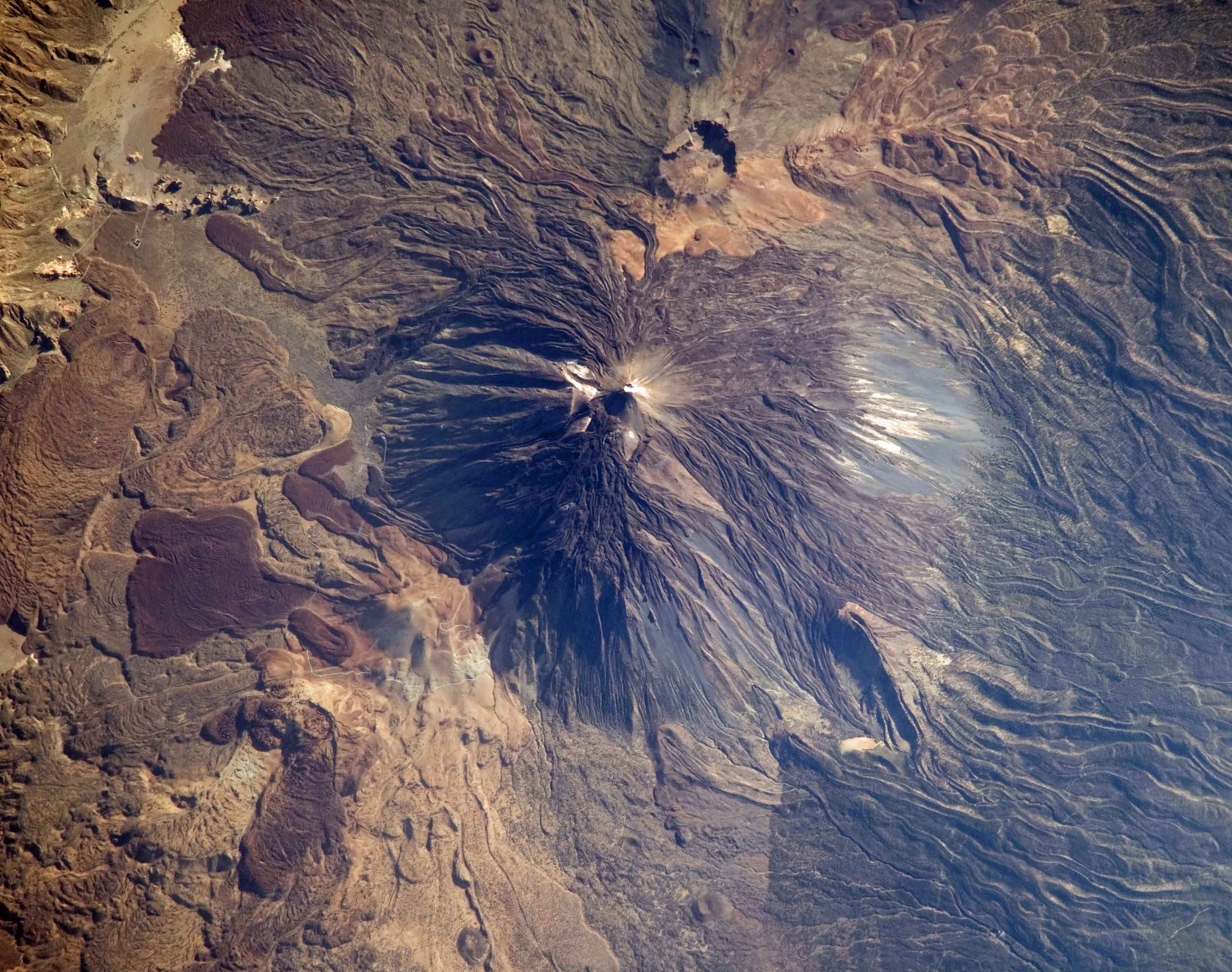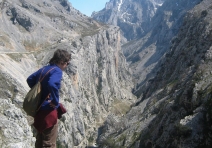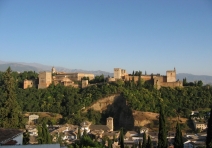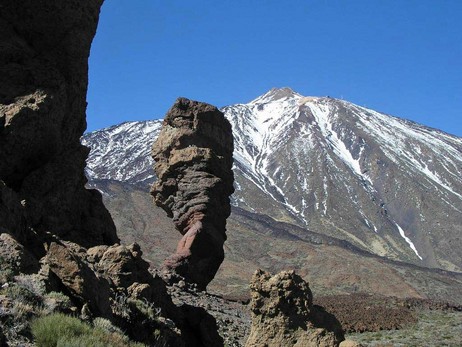A TRAVEL NEWS ARTICLE ABOUT TENERIFE IN THE CANARY ISLANDS
'THE TWO FACES OF TENERIFE'
Tim Ware thought he was visiting one island on his recent trip to Tenerife. It is. But his travels revealed an island with two different personalities.
Guide books tell you there are seven Canary Islands. But to my way of thinking there are eight - because Tenerife, the largest of the group, is effectively two islands in one.

Mount Teide from the North
Clouds brought by the trade winds bump against the north coast of the island, giving moisture and greenery. In contrast the south, in the shadow of the 12,000 feet Mount Teide, is a tourist hot spot of sunny beaches set against the stark background of a semi desert.
As is to be expected the vast majority of Tenerife’s visitors head to the south - to the beaches and bars of the twin resorts of Los Christianos and Playa de las Americas. I divided my time fairly evenly between the sunny south and the more picturesque and historic north.
It’s in the south that Tenerife’s image as a package holiday destination was forged. Here you will find the brash tourism bonanza of cheap souvenir shops, raucous bars and cafes selling British breakfasts, pizzas and burgers by the score. But beyond the cement compounds there are, at Costa Adeje, some surprisingly good hotels, even if they are somewhat built in a style J R Ewing might have felt at home in.

Playa de las Americas
Very much in this mould is the Gran Hotel Bahia del Duque (www.bahia-duque.com) which, with its towers, turrets and spacious balconies, could have been lifted straight from the set of Dynasty. This swish five-star hotel is a gallimaufry of Canarian-styled buildings running down via a series of swimming pools to a semi-private beach below. It’s a place where you might choose to lay down your head for a night or two if you have something to celebrate. The rooms, most of which have sea views, are sumptuously furnished and come complete with satellite TV, mini bar and, in the large modern bathroom, plenty of fragrant potions. The Duque also has no fewer than eight restaurants. There are Spanish, Canarian, French and Italian eateries and what with a newly opened Asian restaurant serving Japanese, Chinese and Thai fare, the dedicated foodie might feel he has the perfect excuse not to leave the hotel’s grounds.
But tempting as it may be to spend one’s time lounging around the pool and sampling the excellent food, what is travel without mobility and the urge to escape? In my case it was to motor up into the mountains – or rather mountain.
The all-dominating Mount Teide, which is often snow capped, rose during volcanic activity 300,000 years ago, leaving a vast craggy lava field – the Canades – in its wake. To reach the peak, a cable car whisks you almost all the way to the top, passing all manner of weird rock formations on the way. The view from Teide is breath-taking. From this lofty perch, amid the gently sulphurous hissing of the still modestly active volcano, it’s possible to see all the islands in the archipelago. But a word of warning. Take care not to allow the sulphur to invade your clothes. On a previous visit I once ruined a good pair of jeans this way.

Mount Teide from above.
This brutal but beautiful area, with its vast fields of lava and boulders strewn by the roadside, has an almost moon-like appearance. But what it lacks in greenery it more than makes up for in drama – and it’s in recognition of this that the Canades has been designated a national park.
After the awesome experience of Teide, I felt I needed something a little more soothing. I headed north to La Laguna, Tenerife’s old ecclesiastical and cultural centre, a place of narrow streets and old houses, some with doors open enabling a glimpse of Moorish-styled patios with plants and tiles inside and sometimes a tinkling fountain.
On friends’ advice I by-passed the island capital Santa Cruz in favour of the Anaga mountains. Anaga is another Canarian surprise – a rugged range intersected by corkscrew valleys which bring to mind the wild countryside of the Pyrenees.

Looking down to Taganana
From the road which dissects the range I dropped down, in spitting rain, along a partly-paved path to the shore below. The path runs for about three miles through to the cliffs and white-walled village of Taganana.
By the time I arrived the sun is out, lighting up the huddle of attractive buildings. Locals chat in shade in the village square and cats and dogs snooze in doorways. At the water’s edge I discover a couple of simple restaurants. It’s lunchtime and I’m tempted by the smell of freshly-caught fish wafting in from the rustique surroundings of the Casa Africa. The restaurant is doing brisk business, mainly with a large group of noisy Germans, and the hostess is busy dispensing appetising plates of fish and carafes of local wine. Soon I’m enjoying a huge plate of grouper, papas arrugadas (potatoes baked in their skins in salty water) and a tasty salad – more than enough to set me up for the afternoon.

Puerto de la Cruz
Then it’s back along the north coast to Puerto de la Cruz, which has been welcoming wintering Brits since the 19th century, attracted by the lushness that comes with a wetter climate. Here in the north there’s an abundance of banana groves and exotic flowers like wild poinsettias and strelitzia grow as rampant as weeds throughout the year.
Puerto de la Cruz is a solid, comfortable resort, with a proper promenade that broadens out in front of the shops, restaurants and hotels that line the seafront. Cafes tempt you with their freshly baked breads and pastries and alluring strawberry gateaux, costing a fraction of what you might expect to pay on the French Riviera.

Two residents of Loro Parque
When you tire of drifting through the streets of the old town, with its attractive wooden balconied houses, you could line up a visit to Loro Parque (loroparque.com) which plays host to the world’s largest parrot collection – more than 200 species in a subtropical garden setting, or to the Botanical Gardens, where you’ll find every variety of palm as well as a huge South American fig tree.

Giant Fig Tree
But back home, what lasts longest in the memory is not Playa de las Americas or Puerto de la Cruz but the familiar, tent-shaped outline of Mount Teide, as influential to the island today as it was when it was created 300,000 years ago.
Monarch Airlines offers low cost flights to Tenerife from Luton in November from around £100 return. Flights are also available from other UK airports. Visit www.monarch.co.uk.
For further information on Tenerife visit www.webtenerife.com.
You may also like to read

SPAIN - TAKING A PEAK AT THE PICOS DE EUROPE
Tour-smart contributer Mike Hampshire and his wife set off on a short-break to explore the unspoilt mountains of Cantabria

SPAIN - A COUNTRY OVERVIEW
As Tour-smart shows, there much more to Spain than sun and glorious beaches.

Comments